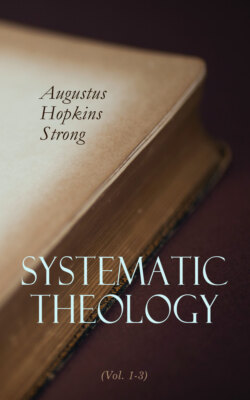Читать книгу Systematic Theology (Vol. 1-3) - Augustus Hopkins Strong - Страница 96
На сайте Литреса книга снята с продажи.
4. Errors of Reasoning.
Оглавление(a) What are charged as such are generally to be explained as valid argument expressed in highly condensed form. The appearance of error may be due to the suppression of one or more links in the reasoning.
In Mat. 22:32, Christ's argument for the resurrection, drawn from the fact that God is the God of Abraham, Isaac, and Jacob, is perfectly and obviously valid, the moment we put in the suppressed premise that the living relation to God which is here implied cannot properly be conceived as something merely spiritual, but necessarily requires a new and restored life of the body. If God is the God of the living, then Abraham, Isaac, and Jacob shall rise from the dead. See more full exposition, under Eschatology. Some of the Scripture arguments are enthymemes, and an enthymeme, according to Arbuthnot and Pope, is “a syllogism in which the major is married to the minnor, and the marriage is kept secret.”
(b) Where we cannot see the propriety of the conclusions drawn from given premises, there is greater reason to attribute our failure to ignorance of divine logic on our part, than to accommodation or ad hominem arguments on the part of the Scripture writers.
By divine logic we mean simply a logic whose elements and processes are correct, though not understood by us. In Heb. 7:9, 10 (Levi's paying tithes in Abraham), there is probably a recognition of the organic unity of the family, which in miniature illustrates the organic unity of the race. In Gal. 3:20—“a mediator is not a mediator of one; but God is one”—the law, with its two contracting parties, is contrasted with the promise, which proceeds from the sole fiat of God and is therefore unchangeable. Paul's argument here rests on Christ's divinity as its foundation—otherwise Christ would have been a mediator in the same sense in which Moses was a mediator (see Lightfoot, in loco). In Gal. 4:21–31, Hagar and Ishmael on the one hand, and Sarah and Isaac on the other, illustrate the exclusion of the bondmen of the law from the privileges of the spiritual seed of Abraham. Abraham's two wives, and the two classes of people in the two sons, represent the two covenants (so Calvin). In John 10:34—“I said, Ye are gods,” the implication is that Judaism was not a system of mere monotheism, but of theism tending to theanthropism, a real union of God and man (Westcott, Bib. Com., in loco). Godet well remarks that he who doubts Paul's logic will do well first to suspect his own.
(c) The adoption of Jewish methods of reasoning, where it could be proved, would not indicate error on the part of the Scripture writers, but rather an inspired sanction of the method as applied to that particular case.
In Gal. 3:16—“He saith not, And to seeds, as of many; but as of one, And to thy seed, which is Christ.” Here it is intimated that the very form of the expression in Gen. 22:18, which denotes unity, was selected by the Holy Spirit as significant of that one person, Christ, who was the true seed of Abraham and in whom all nations were to be blessed. Argument from the form of a single word is in this case correct, although the Rabbins often made more of single words than the Holy Spirit ever intended. Watts, New Apologetic, 69—“F. W. Farrar asserts that the plural of the Hebrew or Greek terms for ‘seed’ is never used by Hebrew or Greek writers as a designation of human offspring. But see Sophocles, Œdipus at Colonus, 599, 600—γῆς ἔμῆς ἀπηλάθην πρὸς τῶν ἐμαυτοῦ σπερμάτων—‘I was driven away from my own country by my own offspring.’ ” In 1 Cor. 10:1–6—“and the rock was Christ”—the Rabbinic tradition that the smitten rock followed the Israelites in their wanderings is declared to be only the absurd literalizing of a spiritual fact—the continual presence of Christ, as preëxistent Logos, with his ancient people. Per contra, see Row, Rev. and Mod. Theories, 98–128.
(d) If it should appear however upon further investigation that Rabbinical methods have been wrongly employed by the apostles in their argumentation, we might still distinguish between the truth they are seeking to convey and the arguments by which they support it. Inspiration may conceivably make known the truth, yet leave the expression of the truth to human dialectic as well as to human rhetoric.
Johnson, Quotations of the N. T. from the O. T., 137, 138—“In the utter absence of all evidence to the contrary, we ought to suppose that the allegories of the N. T. are like the allegories of literature in general, merely luminous embodiments of the truth. … If these allegories are not presented by their writers as evidences, they are none the less precious, since they illuminate the truth otherwise evinced, and thus render it at once clear to the apprehension and attractive to the taste.” If however the purpose of the writers was to use these allegories for proof, we may still see shining through the rifts of their traditional logic the truth which they were striving to set forth. Inspiration may have put them in possession of this truth without altering their ordinary scholastic methods of demonstration and expression. Horton, Inspiration, 108—“Discrepancies and illogical reasonings were but inequalities or cracks in the mirrors, which did not materially distort or hide the Person” whose glory they sought to reflect. Luther went even further than this when he said that a certain argument in the epistle was “good enough for the Galatians.”
